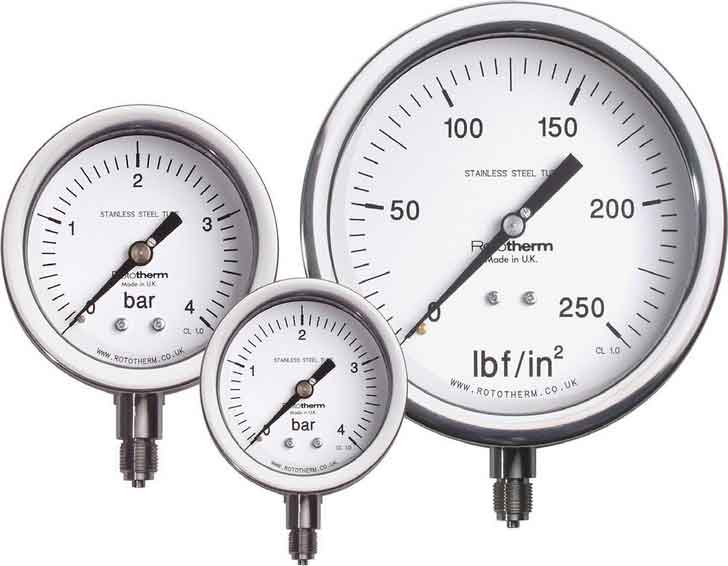 |
Pressure gauges |
Pressure gauges are essential instruments for measuring and monitoring liquid or gas pressure in various industries and applications. Two commonly used types of pressure gauges are liquid-filled pressure gauges and dry pressure gauges, which serve the same purpose.
Although pressure gauges are generally robust mechanical instruments, they can malfunction when exposed to various conditions such as vibrations, mechanical pulsations, temperature peaks, pressure and humidity, as well as unfavorable environmental conditions over a longer period of time.
 Image..
Rototherm.CO.UK
Image..
Rototherm.CO.UK Liquid-filled Pressure Gauges
Protection against vibrations and pulsations
The liquid filling in pressure gauges has an important damping function for vibrations and pulsations.
This is crucial in industrial environments where operating conditions can be extreme and unstable.
The liquid inside the pressure gauge reduces the effects of sudden pressure fluctuations, thus
protecting the device and improving its long-term durability.
Temperature stabilization
Another advantage of liquid filling is the ability to stabilize the internal temperature of the
measuring device. This is particularly important in environments that are subject to extreme temperature
fluctuations. The liquid acts as a heat-regulating medium and reduces the effects of temperature
fluctuations on the reliability of the measured values.
Protection against damage from aggressive media
When pressure gauges are used to measure aggressive or corrosive liquids, a liquid filling can provide
additional protection for the measuring system. The insulating liquid forms an effective barrier
between the aggressive liquid and the internal components of the pressure gauge, extending its
service life and ensuring greater operational safety.
Minimization of measurement errors
Without sufficient liquid filling, pressure gauges can be subject to measurement errors due to phenomena
such as condensation, air bubble formation, or friction effects on the internal mechanism. The
liquid provides a constant and homogeneous interface for pressure transmission, thus minimizing
the possibility of measurement errors.
Increased accuracy and repeatability
Liquid filling helps improve the accuracy and repeatability of measurements. By eliminating or minimizing
external variables that could affect readings, more accurate and reliable results are achieved,
which are essential for the optimal operation of industrial processes.
The filling fluids used in pressure gauges must have certain properties to ensure optimal operation of the device.
When selecting the filling fluid for a pressure gauge, several factors must be taken into account, including chemical compatibility, process temperature, thermal stability and viscosity, cost, and availability.

Glycerin is one of the most commonly used filling fluids for measuring instruments. It has low viscosity and good vibration damping properties, as well as good resistance to temperature fluctuations. It is suitable for general applications where particularly high chemical resistance is not required and is generally used at moderate temperatures, not below -10°C in its pure state and not below -20°C when mixed with water.
Silicone oil fill is known for its thermal and chemical stability. It is the preferred fill fluid for very low temperatures down to -40°C and is particularly suitable for high-temperature applications or aggressive fluids. Silicone is also resistant to oxidation and degradation, making it a reliable choice for corrosive environments.
Halogenated hydrocarbon oil is used in applications that require high chemical resistance, such as with highly corrosive liquids. It is known for its thermal stability and low volatility and is chemically inert, making it well suited for use in the presence of oxygen, chlorine, and other reactive gases.
Dry Pressure Gauges
In certain applications, a liquid-filled pressure gauge may not be the ideal pressure gauge, as its functions may be excessive. Dry pressure gauges are mainly used for industrial machinery such as air compressors. Ideal for environments where mechanical vibrations are not a problem and where there is little to no moisture.

There are several reasons why a dry-type pressure gauge might be preferable to a liquid-filled one.
Cost: Dry pressure gauges are generally less expensive than liquid-filled gauges.
Weight: Dry pressure gauges are typically lighter than liquid-filled gauges, which can be an important factor in some applications.
Ease of installation: Dry pressure gauges are easier to install than liquid-filled gauges because they do not require any special filling or sealing procedures.
Maintenance: Dry pressure gauges generally require less maintenance than liquid-filled gauges, as the filling fluid does not need to be checked or replaced.
Chemical resistance: In some cases, the filling fluid of a liquid-filled pressure gauge is not compatible with the process medium being measured. In such cases, a dry pressure gauge may be the only option.
Temperature range: Some dry pressure gauges are designed for a wider temperature range than liquid-filled gauges.
Both liquid and dry pressure gauges are available in the same pressure ranges, but in some cases liquid pressure gauges may also be available in a higher pressure range.
Related Post(s)

Gauge pressure is a globally used term and can be positive or negative...

Hydrostatic Test Pumps, Temperature and pressure recorder-receiver, Pressure Gauges...